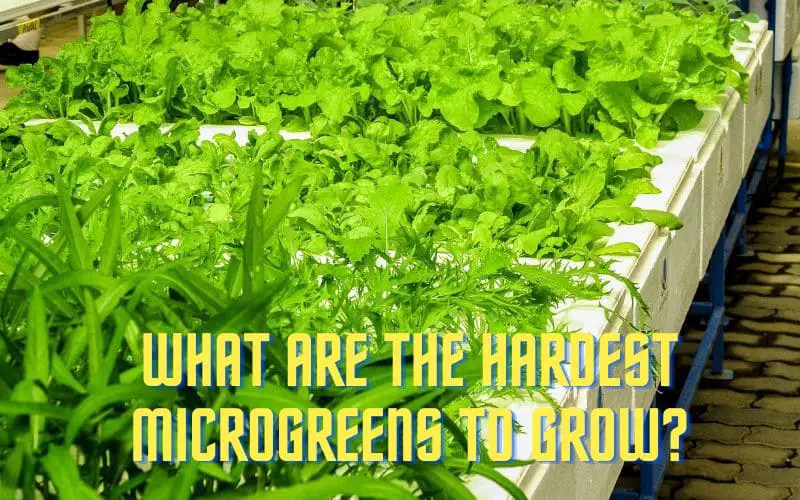What Are The Hardest Microgreens To Grow? Lets Find Out Now!

Introduction
Welcome to our comprehensive exploration of soilless agriculture, where we delve into the fascinating world of growing plants without traditional soil. Throughout this article, we will take an in-depth look at the factors affecting microgreens growth, provide tips for overcoming challenges, and conclude with valuable insights. So, let’s get started!
Answer to the Question
The hardest microgreens to grow can vary depending on various factors such as the growing environment, seeds, and specific care requirements. We will explore this question further in the following sections. We have provided a list of the top five most difficult microgreens to grow. As you go over this list keep in mind that a large portion of your success depends on the type of setup you have and the quality of the hydroponic setup you have.
- Amaranth: Requires precise temperature and humidity control, prone to damping off, and sensitive to overwatering.
- Coriander (Cilantro): Slow germination, susceptible to bolting in warm conditions, and prone to fungal diseases.
- Chia: Tricky to germinate due to gel-like coating on seeds, requires consistent moisture levels, and sensitive to overwatering.
- Basil: Demanding on light and temperature conditions, prone to damping off, and susceptible to fungal diseases.
- Parsley: Slow germination, requires patience and consistent moisture levels, susceptible to root rot, and sensitive to temperature fluctuations.
Factors Affecting Microgreens Growth
Light and Temperature
Microgreens growth is significantly impacted by the availability of light and the temperature of the environment. Adequate light exposure is essential for the photosynthesis process, which is crucial for the healthy development of microgreens. Additionally, maintaining optimal temperature levels is vital for successful growth and germination of microgreens.
When it comes to light, there are several factors to consider, including:
- The duration of light exposure
- The intensity of light
- The quality of light, including the color spectrum
Avoiding direct, intense sunlight is important as it can lead to wilting and scorching of the microgreens. On the other hand, low light exposure can result in leggy and pale microgreens, indicating insufficient photosynthesis. Therefore, finding the right balance of light is crucial for the optimal growth of microgreens.
Regarding temperature, microgreens have specific temperature requirements for different growth stages. These include:
- Seed germination: 70-75°F (21-24°C)
- Growth and development: 60-70°F (15-21°C)
- Harvest: 35-50°F (2-10°C)
Temperature fluctuations outside of these ranges can hinder the growth, development, and flavor of microgreens. Therefore, it’s crucial to monitor and regulate the temperature within the growing environment to ensure the successful cultivation of microgreens.
Seed Quality and Varieties
When it comes to growing microgreens, the quality and variety of seeds used are of utmost importance. The selection of seeds can significantly impact the growth and overall quality of the microgreens. There are several key factors to consider when choosing seeds for microgreens:
- Germination Rate: Opt for seeds with a high germination rate to ensure a successful and consistent growth process.
- Purity: Select seeds that are free from impurities and contaminants, as these can hinder the growth and quality of the microgreens.
- Genetic Diversity: Choosing from a wide range of varieties contributes to a diverse and vibrant harvest of microgreens, offering an array of flavors, textures, and nutritional benefits.
- Adaptability: Consider the adaptability of the seeds to the growing environment and ensure they are well-suited for the intended growing conditions.
Growing Medium and Watering
Growing Medium and Watering
The choice of growing medium and the watering regimen are key factors that influence the growth and development of microgreens. A suitable growing medium, along with a well-balanced watering schedule, is essential to create an optimal environment for the healthy growth of microgreens.
Tips for Overcoming Challenges
Proper Care and Maintenance
Proper Care and Maintenance
Effective care and maintenance practices are crucial for overcoming challenges in microgreens cultivation. Providing consistent care, monitoring growth conditions, and addressing any issues promptly are essential strategies for ensuring successful cultivation of microgreens.
Common Mistakes to Avoid
When it comes to cultivating microgreens, avoiding common mistakes is essential for successful growth and a bountiful harvest. Here, we’ll explore the most prevalent pitfalls and how to steer clear of them:
- Overwatering: Overwatering can lead to root rot and mold, which are detrimental to the health of microgreens. It’s important to strike the right balance and only water when the soil is dry to the touch.
- Low-Quality Seeds: Using inferior quality seeds can significantly impact the growth and quality of the microgreens. Always source high-quality seeds from reputable suppliers.
- Inadequate Light: Insufficient light can result in leggy and pale microgreens. Ensure that the growing area receives adequate natural or artificial light for successful photosynthesis.
- Poor Ventilation: Poor air circulation can lead to fungal diseases and stunted growth. It’s important to provide proper ventilation to maintain a healthy growing environment.
By proactively addressing these common mistakes, growers can foster an optimal environment for their microgreens to thrive and flourish, ultimately leading to a more successful cultivation journey.
Conclusion
In conclusion, the growth and cultivation of microgreens are influenced by multiple factors, ranging from environmental conditions to seed quality and care practices. By understanding and managing these factors effectively, growers can overcome challenges and achieve successful outcomes in cultivating microgreens. We hope this comprehensive exploration has provided valuable insights and practical tips for your microgreens cultivation endeavors.
